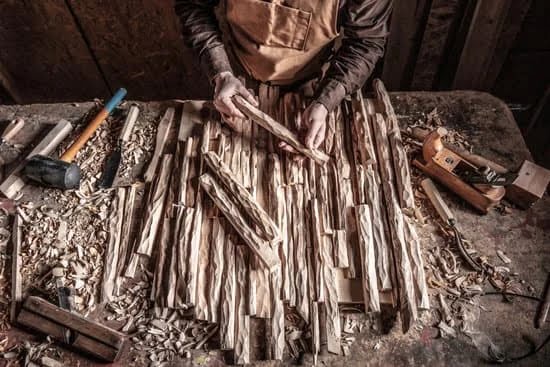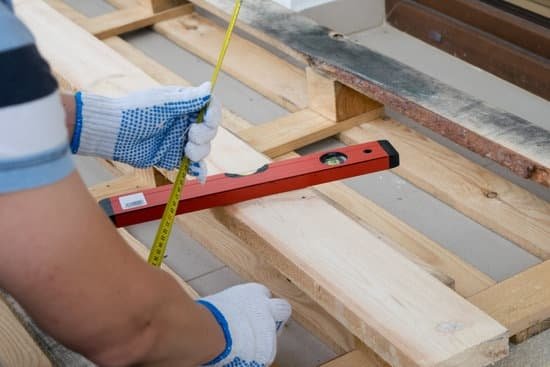Woodworking is an age-old craft that has captivated the hearts and minds of people for centuries. From beautifully crafted furniture to intricate carvings, woodworking offers a unique blend of artistry and practicality. If you’ve ever been curious about this timeless craft and want to dip your toes into the world of woodworking, you’re in the right place.
In this article, we will explore where to start with woodworking and guide you through the essential tools, techniques, and resources needed to embark on your own woodworking journey. Whether you have no previous experience or are looking to enhance your existing skills, we will provide valuable insights to help you get started and progress through different levels of expertise.
Woodworking is not just a hobby; it’s a rewarding art form that allows you to create functional and aesthetically pleasing pieces with your own hands. The satisfaction of transforming a raw piece of wood into something beautiful cannot be overstated. So if you’re ready to unleash your creativity, challenge yourself, and discover the joys of working with wood, let’s dive into the world of woodworking together.
The Essential Tools and Equipment for Woodworking Beginners
Woodworking is a craft that requires specific tools and equipment to bring your projects to life. As a beginner, it’s important to have a basic understanding of the essential tools needed for woodworking. Here are some key tools that every woodworking beginner should consider investing in:
Measuring and Marking Tools
Accurate measurements and markings are crucial in woodworking. Some essential measuring and marking tools include a tape measure, combination square, carpenter’s pencil, marking gauge, and a straightedge. These tools will help you ensure that your cuts and joints are precise.
Cutting Tools
Several cutting tools are necessary for any woodworking project. A circular saw or table saw is great for making straight cuts, while a jigsaw can handle curved or intricate cuts. Additionally, a coping saw or handsaw can be useful for smaller tasks. It’s also important to have different sizes of chisels and carving knives for shaping wood.
Joinery Tools
Joinery is the process of connecting two pieces of wood together. Some essential joinery tools include a mallet or hammer for driving nails or dowels, clamps for securing pieces during assembly, screwdrivers or drills for creating pilot holes, and a router or biscuit joiner for more advanced joinery techniques.
Sanding Tools
Sanding is an important step in woodworking to achieve smooth surfaces before finishing. Basic sanding tools include sandpaper in various grits (ranging from coarse grit for initial sanding to fine grit for finishing), as well as sanding blocks or a random orbital sander.
In addition to these basic tools, there are many other specialized tools available depending on the type of projects you plan on working on. As you gain experience and expand your skills, you may find it beneficial to invest in additional equipment such as a planer, jointer, or lathe. However, starting with the essential tools mentioned above will provide a solid foundation for your woodworking journey as a beginner.
Creating Your Workspace
Setting up a functional woodworking area is crucial for any beginner in woodworking. Having a dedicated space where you can work comfortably and efficiently will not only make your woodworking projects more enjoyable, but it will also ensure safety and enhance creativity. Here are some key considerations when creating your woodworking workspace:
- Space and Layout: Before setting up your woodworking area, assess the available space in your home or garage. Consider the size of your projects, the tools you will be using, and any additional equipment you may need. Aim for a layout that allows for easy movement and access to all necessary tools.
- Workbench: A sturdy workbench is an essential component of a functional woodworking area. It should be large enough to accommodate your projects and equipped with vises or clamps to secure the wood while working on it. Additionally, include storage options within or near the workbench to keep your tools organized and easily accessible.
- Lighting and Ventilation: Good lighting is crucial for accurate measurements, precise cuts, and overall safety. Ensure that your woodworking area has sufficient natural light during the day, supplemented by overhead or task lighting as needed. Adequate ventilation is also important when working with wood dust or using finishes that emit fumes.
- Power Supply: Consider the power requirements of your tools and set up adequate electrical outlets in your workspace to avoid overloading circuits or using unsafe wiring methods. Install ground fault circuit interrupters (GFCIs) where necessary for added safety.
| Considerations | Tips |
|---|---|
| Space and Layout | – Assess available space\n – Consider project size\n – Plan layout for easy movement |
| Workbench | – Choose a sturdy bench\n – Ensure it’s large enough\n – Include storage options |
| Lighting and Ventilation | – Have sufficient natural light\n – Supplement with adequate task lighting\n – Ensure proper ventilation for safety |
| Power Supply | – Determine power requirements of tools\n – Install appropriate electrical outlets\n – Use GFCIs where necessary |
By considering these factors and setting up your woodworking area thoughtfully, you will create a space that promotes efficiency, creativity, and most importantly, safety. Remember to keep your workspace clean and organized to ensure a clutter-free environment that allows for smooth workflow. With a functional woodworking area at your disposal, you are ready to dive into the world of woodworking and embark on exciting projects.
Learning the Basics
Understanding the basics of woodworking is essential for anyone looking to embark on this rewarding craft. Learning about wood types, cuts, and joints will lay a solid foundation for your woodworking journey.
When it comes to wood types, there are various options to choose from depending on your project and desired outcome. Some common wood types used in woodworking include pine, oak, maple, birch, and cherry. Each type of wood has its own characteristics in terms of color, grain pattern, and hardness. It’s important to consider these factors when selecting the right wood for your project.
In addition to understanding different wood types, it’s also important to familiarize yourself with different cuts that can be made in woodworking. The three most common cuts are crosscuts, rip cuts, and miter cuts. A crosscut is made across the grain of the wood, while a rip cut goes along the grain.
Miter cuts are angled cuts typically used for creating corners or frames. Familiarizing yourself with these basic cutting techniques will give you more flexibility and precision in your woodworking projects.
Understanding different joints is another crucial aspect of learning the basics of woodworking. Joints are essential for connecting two pieces of wood together securely. Some common types of joints include butt joints, lap joints, miter joints, and dovetail joints. Each joint has its own strengths and weaknesses in terms of strength and appearance.
To summarize:
- Familiarize yourself with different wood types to select the right one for your project.
- Learn about different cutting techniques such as crosscuts, rip cuts, and miter cuts.
- Gain knowledge about various joint options like butt joints, lap joints, miter joints, and dovetail joints.
By mastering these basics of understanding wood types, cuts, and joints early on in your woodworking journey,
you will have a solid foundation to build upon as you tackle more challenging projects in the future.
Where to Source the Best Wood for Your Projects
When it comes to woodworking, the quality of the wood you use can greatly impact the final outcome of your projects. It’s important to source the best wood possible for your woodworking creations. But where do you find the best wood for your projects? Here are a few options to consider:
- Local Lumberyards: Local lumberyards are a great place to start when looking for high-quality wood. These establishments typically offer a wide selection of wood types and grades to choose from. Not only can you physically see and feel the wood before purchasing, but the staff at lumberyards can also provide valuable guidance and recommendations based on your specific project needs.
- Specialty Wood Suppliers: If you’re looking for unique or exotic woods, specialty wood suppliers may be your best bet. These suppliers often carry a wider range of wood species that may not be available at local lumberyards. Whether you need highly figured hardwoods, reclaimed wood, or rare imported species, these suppliers can help fulfill your specific requirements.
- Online Retailers: In today’s digital age, online retailers have become increasingly popular sources for purchasing woodworking materials, including wood. Many online retailers offer a wide variety of wood types and cuts that can be conveniently delivered right to your doorstep. When purchasing from an online retailer, it’s important to read customer reviews, check their return policy, and ensure they have a good reputation within the woodworking community.
- Salvaged or Reclaimed Wood: For those who prefer sustainable and environmentally-friendly options, salvaged or reclaimed wood is an excellent choice. This type of wood is sourced from old buildings, barns, or other structures that would otherwise go to waste. Salvaged or reclaimed wood adds character and history to your projects while reducing environmental impact.
Remember that selecting the right type of wood depends on various factors such as project requirements, budget constraints, personal preference, and availability. It’s always beneficial to look around and compare options before making a final decision. By sourcing the best wood for your projects, you’ll enhance the overall quality and appearance of your woodworking creations.
Starting Small
When starting out in woodworking, it’s important to choose projects that are suitable for your skill level. Starting small with easy woodworking projects not only allows beginners to learn and practice the basic techniques but also provides a sense of accomplishment and motivation to continue honing their skills. Here are a few ideas for easy woodworking projects that beginners can try:
Wooden Cutting Board
One of the simplest yet practical projects for beginners is making a wooden cutting board. This project helps you practice basic woodworking techniques such as measuring, cutting, sanding, and finishing. Start by choosing a durable hardwood like maple or walnut, then cut it into the desired shape and size using a saw or a handheld router. Sand down the edges and surfaces until smooth before applying food-safe finish like mineral oil or beeswax.
Floating Shelves
Floating shelves are an excellent way to add some storage and display space to any room. For beginners, this project is an opportunity to learn about creating strong joints using screws or dowels, as well as practicing accurate measurements and leveling. Choose a lumber that matches your desired aesthetic, cut it into individual shelf pieces, then attach them to the wall using mounting brackets or hidden cleats.
Simple Picture Frame
Making a picture frame allows beginners to experiment with miter cuts and get comfortable with using various types of joinery like butt joints or splines. It’s also an opportunity to showcase creativity by selecting unique wood species or adding decorative touches like routed edges or woodburned designs. Simply measure and cut the frame pieces to fit your photo size, assemble them using glue and clamps, then sand and finish for a polished look.
Remember, these projects are just starting points – think of them as building blocks for developing your skills as a woodworker. As you complete these easy projects, you’ll gain confidence and knowledge that can be applied to more complex endeavors in the future. Take your time, enjoy the process, and don’t hesitate to seek guidance or inspiration from online tutorials, woodworking books, or fellow woodworkers.
Essential Safety Tips for Woodworking Newbies
Woodworking is a rewarding and fulfilling hobby, but it’s important to always prioritize safety. Whether you’re a beginner or have been woodworking for years, it’s crucial to follow safety guidelines to protect yourself from accidents and injuries. Here are some essential safety tips for woodworking newbies:
Wear Appropriate Safety Gear
One of the most important safety precautions in woodworking is wearing proper safety gear. Always wear safety goggles or glasses to protect your eyes from flying wood chips, sawdust, and debris. Additionally, use ear protection like earmuffs or earplugs to minimize the impact of loud power tools on your hearing. Don’t forget about respiratory protection as well – using a dust mask or respirator can prevent inhaling harmful particles.
Take Time to Familiarize Yourself with Tools
Before using any woodworking tool, take the time to read the instruction manual thoroughly and understand how it works. Each tool has its unique features and operating techniques, so familiarizing yourself with them will help prevent accidents caused by incorrect usage. Pay attention to details such as proper blade adjustments, depth settings, and safe cutting techniques.
Maintain a Clean and Organized Workspace
A clean and organized workspace not only promotes efficiency but also enhances safety. Clear away clutter from your work area before starting any project. This includes removing scrap wood pieces, excess sawdust or shavings, and other debris that may accumulate during the woodworking process. Having a clean workspace reduces trip hazards and minimizes the risk of accidentally coming into contact with dangerous objects.
Practice Proper Tool Handling
Whether you’re using hand tools or power tools, it’s critical to practice proper tool handling techniques. Always hold tools securely with both hands when in use and avoid wearing loose clothing or jewelry that may get caught in machinery. When passing tools to others, do so with the handle facing them to prevent accidental injuries. Never leave a power tool running unattended, and be mindful of your body positioning and posture to maintain stability while operating tools.
By following these essential safety tips, woodworking newbies can ensure a safe and enjoyable experience. Remember that safety should always be a priority, so don’t hesitate to invest in quality safety gear and take the time to understand and use tools properly.
Building Your Skills
Woodworking is a craft that requires both skill and knowledge to master. While practicing on your own can be beneficial, taking woodworking classes or workshops can greatly accelerate your learning process and help you build your skills more effectively. These classes provide structured lessons from experienced instructors, often with hands-on practice opportunities and valuable feedback. Here are some recommended woodworking classes and workshops to consider:
- Community Education Programs: Many local schools and community centers offer woodworking classes for beginners. These programs are usually affordable and provide a supportive learning environment. In these classes, you can learn the basics of working with wood, using tools safely, and creating simple projects.
- Woodworking Schools: If you are serious about woodworking and want to develop advanced skills, attending a specialized woodworking school may be the right choice for you. These schools offer comprehensive courses ranging from beginner to advanced levels, taught by experienced professionals. Some well-known woodworking schools include The Center for Furniture Craftsmanship and The North Bennet Street School.
- Woodworking Workshops: Workshops are typically shorter in duration compared to full-length classes or programs but still provide valuable insights into specific techniques or project types. These workshops are often taught by expert woodworkers who focus on specific areas such as hand tool use, joinery techniques, or furniture making.
Learning from experienced instructors not only ensures that you receive accurate information but also allows you to ask questions, gain personalized guidance, and receive feedback on your work. Additionally, being part of a class or workshop provides an opportunity to connect with other enthusiasts at different skill levels and share knowledge and experiences.
Recommended Woodworking Classes and Workshops
| Name | Description | Location |
|---|---|---|
| The Center for Furniture Craftsmanship | A diverse range of hands-on courses for all skill levels, covering various woodworking techniques and project types. | Rockport, Maine |
| The North Bennet Street School | Offers full-time programs, workshops, and classes focusing on traditional craftsmanship and fine woodworking. | Boston, Massachusetts |
| The Woodworker’s Guild of America | An online platform providing video-based lessons and tutorials on a wide range of woodworking topics for all skill levels. | Online |
By investing in your education through classes and workshops, you can learn new techniques, improve your craftsmanship, and gain the confidence needed to take on more complex projects. These learning opportunities can also inspire you to explore different aspects of woodworking and discover your own unique style.
Connecting with the Woodworking Community
Woodworking can be an incredibly gratifying and fulfilling hobby, but it doesn’t have to be a solitary journey. Connecting with the woodworking community can provide a wealth of knowledge, support, and inspiration as you embark on your woodworking endeavors. Online forums, social media platforms, and local groups are excellent resources for connecting with like-minded individuals who share your passion for woodworking.
Online forums dedicated to woodworking are abundant and offer a platform for woodworkers of all skill levels to share their experiences, ask questions, and seek advice. These forums often have sections devoted to specific aspects of woodworking such as tool recommendations, project ideas, or troubleshooting common challenges. Participating in these discussions can not only help you learn from more experienced woodworkers but also provide a space where you can seek guidance when faced with obstacles in your projects.
Social media platforms such as Instagram, Facebook groups, and YouTube channels have become popular hubs for woodworkers to showcase their work and connect with other enthusiasts. Following skilled woodworkers on these platforms can offer inspiration for future projects and provide valuable insights into their techniques. Additionally, many communities hold regular challenges or contests where participants can showcase their skills and receive feedback from fellow woodworkers.
In addition to online communities, joining local woodworking groups or clubs allows you to connect with woodworkers in your area face-to-face. These groups often organize workshops or demonstrations where members can learn new techniques or share their knowledge with others. Being part of a local group provides not only an opportunity to expand your network but also allows you to access a shared workspace or borrow specialized tools that may otherwise be expensive or difficult to obtain.
By connecting with the wider woodworking community through online forums, social media platforms, and local groups, you can tap into a vast pool of knowledge while forging connections with fellow enthusiasts. Whether seeking advice on technique or simply sharing the excitement of completing a project, engaging with this passionate community can elevate your woodworking journey and fuel your creativity.
| Online Forums | Social Media Platforms | Local Groups |
|---|---|---|
| Woodworking Talk | Instagram: #woodworkingcommunity | City Woodworkers Guild |
| The Wood Whisperer Forum | Facebook Groups: Woodworking Enthusiasts United | Craftsmen’s Clubhouse |
| Sawmill Creek Woodworkers Forums | YouTube Channels: Woodworking Masterclass, The Samurai Carpenter | Community DIY Workshop Space Association |
Overcoming Common Challenges
Woodworking, like any craft, comes with its fair share of challenges. No matter how experienced or skilled you become, it is likely that you will encounter various obstacles along the way. However, the ability to troubleshoot and problem-solve is an essential skill for any woodworker to develop. In this section, we will explore some common challenges in woodworking and discuss strategies for overcoming them.
One of the most common issues woodworkers face is wood movement. Wood is a natural material that expands and contracts in response to changes in humidity and temperature. This movement can cause problems such as warping, splitting, or joints coming loose. To address this challenge, it is important to understand the characteristics of different wood species and their suitability for specific projects. Additionally, proper drying and acclimation techniques can help minimize the effects of wood movement.
Another challenge in woodworking is achieving precise measurements and cuts. Even a small measurement error can result in ill-fitting joints or misaligned pieces. To overcome this challenge, it is crucial to use accurate measuring tools such as a tape measure or a combination square.
Taking the time to double-check measurements before making cuts can save you from costly mistakes. It is also helpful to practice your cutting techniques on scrap pieces of wood before working on your actual project.
Finally, finishing and sanding can present its own set of challenges. Achieving a smooth surface free from scratches or blemishes requires attention to detail and patience. Inconsistent sanding pressure or using the wrong grit sandpaper can result in uneven surfaces or over-sanding certain areas. The key to successful finishing and sanding lies in taking your time, starting with a coarse grit sandpaper and gradually working your way up to finer grits.
Expanding Your Tools and Knowledge
Woodworking is a craft that allows for continuous growth and learning as you advance your skills. Once you have mastered the basic woodworking techniques and completed several beginner projects, it’s time to expand your tools and knowledge by exploring intermediate woodworking techniques and projects. This section will provide you with guidance on how to take your woodworking skills to the next level.
When it comes to expanding your tools, there are several key additions that can enhance your woodworking capabilities. Some essential tools for intermediate woodworkers include a miter saw, a router, a jointer, and a planer.
A miter saw is perfect for making accurate crosscuts and angled cuts, while a router can be used for creating decorative edges and joinery work. A jointer will help you achieve perfectly flat surfaces, and a planer will allow you to achieve consistent thickness throughout your project.
With these additional tools at hand, you can now dive into more complex woodworking techniques. One popular technique among intermediate woodworkers is creating dovetail joints. Dovetail joints are known for their strength and aesthetic appeal. These joints require precision and attention to detail but once mastered, they can elevate your woodworking projects to another level.
As an intermediate woodworker, you can also start experimenting with more detailed designs and challenging projects. For example, consider building furniture pieces such as coffee tables or bookshelves that incorporate more intricate joinery techniques like mortise and tenon joints or finger joints. These projects will not only showcase your growing skill set but also give you confidence in taking on more ambitious endeavors.
Expanding your knowledge in woodworking can also involve researching different types of wood species that offer unique characteristics for various projects. There is an abundance of resources available online or through books where you can learn about the different properties of wood, such as durability, grain pattern, and color variations. Additionally, studying advanced finishing techniques will allow you to achieve professional-looking results that enhance the beauty of your woodworking projects.
By expanding your tools and knowledge through intermediate woodworking techniques and projects, you are honing your skills and setting the stage for even more challenging projects in the future. Remember to stay patient and persistent as you learn new techniques, as it takes time and practice to master them. Embrace this phase of your woodworking journey and enjoy the satisfaction that comes from creating intricate, well-crafted pieces.
Taking Your Woodworking to the Next Level
Taking your woodworking skills to the next level involves delving into advanced techniques and creating masterful pieces. Once you have built a strong foundation of basic woodworking skills and knowledge, you can explore more complex projects that challenge your abilities and allow you to showcase your creativity.
Advanced woodworking techniques often involve intricate joinery, carving, inlay work, and advanced finishing techniques. These techniques require precision, patience, and attention to detail. It is important to continue learning and practicing these skills to refine your craftsmanship and expand your repertoire.
One way to advance your woodworking skills is by seeking out specialized classes or workshops. These classes are taught by experienced woodworkers who can guide you through advanced techniques step-by-step. Many community colleges, vocational schools, and woodworking studios offer courses tailored for intermediate and advanced woodworkers. These classes not only provide hands-on instruction but also an opportunity to network with fellow enthusiasts and learn from their experiences.
In addition to taking classes, it is also beneficial to explore online resources such as tutorials, forums, and video demonstrations. There are numerous websites dedicated to sharing advanced woodworking techniques and projects. You can find instructional videos on platforms like YouTube or join online forums where woodworkers share tips, tricks, and advice.
By continuously challenging yourself with more complex projects and techniques, you will further develop your craftsmanship and problem-solving skills in woodworking. Remember that mastery takes time and practice, so do not be discouraged if you encounter difficulties along the way. Embrace the journey of constantly learning and improving your woodworking abilities as you create beautiful masterpieces that showcase your passion for this timeless craft.
Conclusion
Woodworking is not just a hobby or a craft; it is an art form that allows individuals to express their creativity and connect with the natural beauty of wood.
Throughout this article, we have explored the essential tools and equipment needed for beginners, setting up a functional workspace, learning the basics of wood types and cuts, sourcing the best wood for projects, starting small with easy projects, prioritizing safety, building skills through classes and workshops, connecting with the woodworking community, troubleshooting common challenges, and progressing to intermediate and advanced techniques.
As you embark on your woodworking journey, it is important to remember that it is not just about the final product-it is about embracing the entire process. Woodworking requires patience, practice, and perseverance. Each project offers an opportunity to learn new techniques, refine your skills, and overcome obstacles along the way.
One of the most rewarding aspects of woodworking is unlocking your own creativity. Whether it is designing your own projects or adding personal touches to existing plans, woodworking allows you to explore your artistic side. Don’t be afraid to experiment with different finishes or incorporate other materials into your work.
Allow yourself to make mistakes and learn from them. With each project completed, you will gain confidence in your abilities and find joy in seeing your ideas come to life.
So as you begin this exciting journey into woodworking, remember that it takes time to master this craft. Enjoy every step along the way-celebrate both successes and failures-and continue pushing yourself to explore new techniques and challenge your skills. Embrace the beauty of working with wood and let it inspire you to unleash your creativity like never before. Happy woodworking.
Frequently Asked Questions
How do I get started with woodworking?
Getting started with woodworking involves a few essential steps. First, familiarize yourself with the basic tools required for the craft, such as a table saw, chisels, hand planes, and a router. Next, educate yourself on woodworking techniques and joinery methods through books or online resources.
It’s also beneficial to join a local woodworking club or take a class to learn from experienced woodworkers and gain practical knowledge. As you start your first projects, it’s important to prioritize safety by wearing protective gear and practicing proper tool usage. Finally, remember that practice makes perfect – start with simple projects and gradually work your way up to more challenging ones to develop your skills.
Can I teach myself woodworking?
Absolutely! Woodworking is a skill that can be self-taught through diligent practice and learning from available resources. With the abundance of instructional guides, videos, and blogs dedicated to woodworking, it has never been easier to teach yourself this craft.
Start by familiarizing yourself with woodworking terminology and understanding the fundamental concepts. From there, gradually build up your knowledge base by watching tutorials or reading beginner-friendly books on woodworking techniques. Additionally, trial and error will be an integral part of your self-taught journey in order to hone your skills and improve over time.
What is the best beginner woodworking wood?
The best wood for beginners in woodworking is generally considered softwoods such as pine or spruce. These woods are readily available at most home improvement stores and are relatively inexpensive compared to hardwoods like oak or mahogany. Softwoods are easier to work with due to their softer nature, making them more forgiving when mistakes occur or adjustments need to be made during the learning process.
They are also less prone to splintering or chipping when using hand tools like chisels or hand planes. Pine specifically is a popular choice for beginners because it offers good workability while still providing satisfactory results in many projects like shelves, cabinets, or small furniture pieces.

Hi everyone! I’m a woodworker and blogger, and this is my woodworking blog. In my blog, I share tips and tricks for woodworkers of all skill levels, as well as project ideas that you can try yourself.





